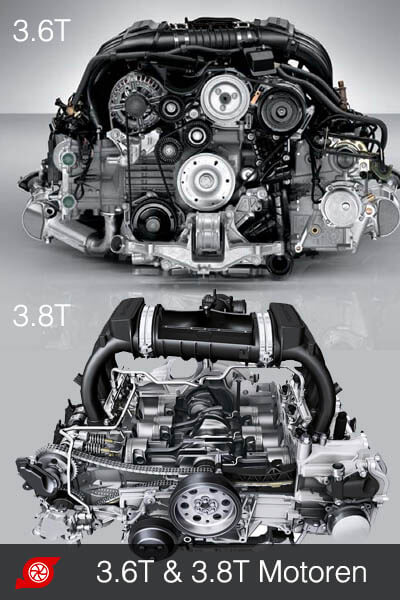
Porsche has several versions of each of their models. For the 911 these usually include the Carrera, Turbo and track-oriented GT3 and GT2, with several special edition models to go along. However, each of the mentioned versions has a more hardcore brother, usually named S, or RS in the case of the GT2 and GT3. These offer software adjustments and some usually minor changes that up the power (speaking of the Porsche 911 997.2) by 30 hp to 50 hp (90 hp for the GT2 RS) – enough to make a difference, but not enough to jeopardize the superiority of the next model in the lineup. Well, you can save some money and skip several models by tuning a lesser model. For this example, we’ve opted for the 997.2, since it is a discontinued model, and it’s Turbo variant, due to the fact that, well, it has a damn turbocharger and that’s great for tuning. Our tuning experts performed their art on the Turbo and got it to 82 hp more instead of just 30 hp. Yes, GT Kraft provides the Porsche 911 997.2 Turbo with 582 hp (428 kW) and 803 Nm (592 lb-ft) of torque. The power comes from software tweaks and new intake and exhaust parts, but you can even opt for a cheaper version of the upgrade that keeps the hardware stock and provides 552 hp (406 kW) and 743 Nm (548 lb-ft) from ECU tuning alone.
Every 911 is a beast. Many of them are seriously faster than most cars with more cylinders and power, which is as unique as their retro-inspired, but modernized styling. They all come with a boxer engine with 6 cylinders placed at the far back. This makes gravity center far lower (due to the boxer layout) and the car beautifully balanced for a completely unique driving feel. These features alone made even the initial Porsches with low power ratings incredibly interesting to drive. However, when the 930 appeared in the 1970s, bearing a turbocharger, Porsche 911 went from being a great sports car to being one of the best supercars in the world, while still keeping its distinctive quality. From that moment onwards, each generation of the venerated 911 has come with a turbocharged option. The facelift of the 997 version might be one of the best examples so far, boasting 500 hp (368 kW) and 650 Nm (479 lb-ft) from the 3.8 l B6 twin-turbo. It takes just 3.5 seconds to reach 100 km/h (62 mph) and this is the official figure, but Porsche is famous for being conservative with these statements, many of their cars going noticeably faster that they state. We don’t know the reason for this, but we do know that the GT Kraft tuned Porsche 911 997.2 Turbo clocked 100 km/h in just 3 seconds. Moreover, the facelift came with numerous improvements to the suspension, all new engines and the famous PDK (if you don’t opt for the manual), so it is a proper track beast. Now just add some tuning and it becomes more powerful than the Turbo S, GT3 RS and even the stunning turbocharged track-beast that the GT2 is. After our expert team has had some fun with your Turbo, the only more powerful version of the 997 is the spartan GT2 RS and the difference is less than 40 hp. If we’re talking about everyday driving, the GT Kraft 997.2 Turbo is by far the best and fastest option.
This is how it works. They put the car in a dyno and measure its current performance and check the general state. After that, they increase the turbo pressure to give the engine more air and adjust the amount of fuel to accompany the additional air. This is done by altering the OEM ECU’s software and, for proper tuning (the only one that you should ever use), it is custom made for each engine. The changes need to be spot on and working together.
The last change for the stage 1 is an alteration of the ignition timing, which is advanced to improve combustion and throttle response at the same time. The added power and torque already make the car noticeably more responsive, but improving the throttle response is a whole new level of instant reaction.
So, what is the new power rating? The stage 1 brings 552 hp (406 kW) and 743 Nm (548 lb-ft) which already makes the tuned Porsche 997.2 Turbo faster than the Turbo S, GT3 RS and GT2. Even though the car got a significant boost, it is perfectly safe. This kind of reliability comes from the fact that the car is extensively tested on a Superflow 4×4 dynamometer and that all of the adjustments are carefully monitored. Not a single part is stressed above the levels that the manufacturers see as safe. But, there’s a way to make the car even more powerful and safer at the same time. That’s the stage 2.
The car gets safer because it gets new intake and exhaust parts which actually relieve the stress that the OEM parts feel. This kind of an upgrade makes room for further adjustments of the ECU software. But let’s see what the new hardware is first. FabSpeed intercooler improves cooling of the intake air and sends more oxygen to the combustion chambers. On the other side of the engine, you get a new exhaust produced by Supersprint, Milltek or Akrapovic, each of which is lighter than the one you get with the car.
After these parts have been installed, the engine gets more oxygen and lets off the exhaust gases easier which calls for more software adjustments and dyno tests. The result comes to about 582 hp (428 kW) and 803 Nm (592 lb-ft) which makes the 997.2 Turbo the second most powerful version of the 997 behind the GT2 RS which is a proper track car, devoid of most comfort perks and with suspension tuned for performance rather than everyday driving.